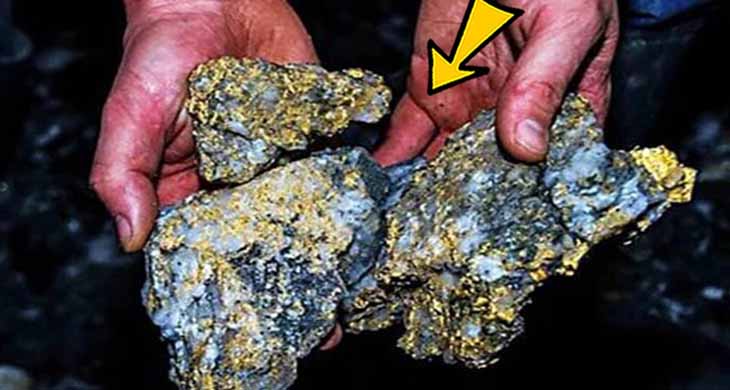Man Kept “Gold Rock” For Years Before Scientists Told Him The Truth

Dave Hole, a passionate treasure hunter with a penchant for exploring Maryborough Regional Park, stumbled upon an extraordinary find in 2015 that would take him on a journey deep into the mysteries of our universe. What began as a typical search for hidden treasures beneath the Earth’s surface led to an encounter with a mysterious red rock that defied explanation.
The Mysterious Red Rock
While following his usual route through the park, Dave Hole discovered a peculiar-looking rock in 2015. This rock, unlike any he had seen before, not only felt surprisingly heavy but also seemed to possess an unyielding sturdiness that piqued his curiosity. Hole had a hunch that this rock might be something special, but he didn’t want to jump to conclusions.
Determined to uncover the truth, Hole attempted various methods to break open the rock, from conventional tools to a sledgehammer, but it remained impervious. Intrigued and perplexed, he decided to keep the rock at his home, hoping that one day he could unlock its secrets.
A Chance Meeting at the Melbourne Museum
It wasn’t until 2019 that Dave Hole decided to seek professional assistance in unraveling the mystery of his rock. He headed to the Melbourne Museum, where he met geologist Dermot Henry, an expert in testing and authenticating samples brought in by the public.
Dermot Henry, with 37 years of experience at the museum, had tested thousands of samples. However, only two had ever turned out to be real meteorites. When Hole presented his unusual find, Henry was initially intrigued by the rock’s sculpted, dimpled appearance, which hinted at its meteoritic origin.
Upon closer examination and handling, the rock’s unusual weight and characteristics pointed towards it being a genuine meteorite. Both Henry and Hole were astonished by the revelation.
The Origin of the Meteorite
The meteorite, identified as H5 chondrite, turned out to be a remarkable specimen. Not only was it a genuine meteorite, but it also carried an age of 4.6 billion years, making it an extraordinary relic from the very origins of our solar system.
Henry cut a cross-section of the meteorite, revealing silver droplets inside. These droplets had formed billions of years ago, crystallizing from the hot gas cloud that gave birth to our solar system. This meteorite, in essence, was a time capsule from the distant past, offering a glimpse into the formation of our universe.
The Meteorite’s Journey to Earth
The story of H5 chondrite began billions of years ago when these celestial rocks orbited the Sun, forming part of the early solar system. Over time, they coalesced, giving rise to the rocky planets, including Earth. However, remnants of these chondrites remained, orbiting in the asteroid belt between Jupiter and Mars.
Occasionally, collisions between these remnants sent shards hurtling towards Earth, initiating a one-of-a-kind event. Residents of Maryborough in the 1950s reported witnessing balls of fire streaking across the night sky, likely linked to the arrival of this particular chondrite.
Dave Hole’s discovery in 2015, thanks to his intuition and determination, shed light on the extraterrestrial origins of this meteorite. Records from local newspapers in the 1950s further corroborated the connection, with eyewitness accounts of celestial phenomena.
The Murchison Meteorite: A Stinky Extraterrestrial Mystery
In September 1969, the town of Murchison in Victoria, Australia, witnessed an otherworldly spectacle as a meteorite blazed through the atmosphere. The community mobilized to search for remnants of this extraterrestrial visitor, and the search was successful.
Residents discovered numerous meteorite fragments, and scientists worldwide were eager to study these celestial relics. However, what set the Murchison meteorite apart was its peculiar scent. Those who handled it reported a range of unusual odors, including tar, methylated spirits, wet hay, and even rotten peanut butter.
Researchers eventually discovered that the unique scents emanated from volatile compounds trapped within the meteorite. Over time, as these compounds escaped, they contributed to the intriguing and sometimes unpleasant odors associated with the space rock.
Unveiling the Secrets of Ancient Grains
To uncover the meteorite’s age and secrets, researchers embarked on a meticulous analysis. By examining pre-solar grains within the rock, they could estimate its approximate age. The meteorite was crushed to extract pre-solar silicon carbide, which dated back to an astonishing 5.5 to 7 billion years old.
However, an unexpected twist occurred during the analysis. The meteorite, exposed to Earth’s atmosphere and subjected to various processes, began to emit different odors. Scientists described these scents as earthy, reminiscent of wet hay, or even sweet, like vanilla.
A Journey into the Mysteries of Space
While Dave Hole’s discovery took him on an unexpected journey into the mysteries of the universe, it also showcased the enduring allure of space rocks and their ability to captivate the imagination. Meteorites like H5 chondrite and the Murchison meteor.




